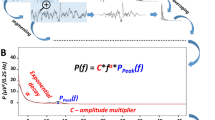Abstract
A computer program for the analysis of a sleep electroencephalogram (EEG) is presented. The method relies on two steps. First, a spectral analysis is performed for signals recorded from one or more electrode locations. Then, two EEG parameters are obtained by storing the spectral activity in a multidimensional space, whose dimension is reduced using principal component analysis (PCA) techniques. The main advantage of these parameters is in describing the process of sleep on a continuous scale as a function of time. Validation of the method was performed with the data collected from 16 subjects (8 young volunteers and 8 elderly insomniacs). Results snowed that the parameters correlate highly with the hypnograms established by conventional visual scoring. This signal parametrisation, however, offers more information regarding the time course of sleep, since small variations within individual sleep stages as well as smooth transitions between stages are assessed. Finally, the concurrent use of both parameters provides an original way of considering sleep as a dynamic process evolving cyclically in a single plane.
Similar content being viewed by others
References
Achermann P, Borbély AA (1987) Dynamics of EEG slow wave activity during physiological sleep and after administration of benzodiazepine hypnoptics. Hum Neurobiol 6:203–210
Agnew HW Jr (1973) Integrator analysis of the sleep electroencephalogram. Electroencephalogr Clin. Neurophysiol. 34:391–397
Barlow JS, Creutzfeldt OD, Michael D, Houchin J, Epelbaum H (1981) Automatic adaptive segmentation of clinical EEG. Electroencephalogr Clin Neurophysiol 51:512–525
Borbély AA (1982) A two-process model sleep regulation. Hum Neurobiol 1:195–204
Bouard G, Benoit O, Lacombe J (1984) Le traitement du signal en électrophysiologie expérimentale et clinique du système nerveux central. Actes du Congrès International, Paris, 11–15 December 1984, vol II, Chap 6, pp 533–544
Carskadon MA, Rechtschaffen A (1989) Monitoring and staging human sleep. In: Kryger MH, Roth T, Dement WC (eds) Principles and practice of sleep medicine. Saunders, Philadelphia, pp 665–695
Creutzfeldt OD, Bodenstein G, Barlow JS (1985) Computerized EEG pattern classification by adaptive segmentation and probability density function classification — clinical evaluation. Electroencephalogr Clin Neurophysiol 60:373–393
Czeisler CA et al. (1980) Glossary of standardised terminology for sleepbiological rhythm research. sleep 2:287–288
Dirlich G Friedrich-Freksa C, Schulz H (1973) A time dependent model of sleep EEG. In: Koella WP, Levin P (eds) Sleep. Physiology biochemistry, psychology, pharmacology, clinical implications. Karger, Basel, pp 253–257
Escola H, Poiseau E, Jobert M, Gaillard P (1991) Classification using distance-based segmentation — application to the analysis of EEG signals. Pattern Recogn Lett 12:327–333.
Frost JD Jr (1970) An automatic sleep analyser. Electroencephalogr Clin Neurophysiol 29:88–92
Gaillard JM, Tissot R (1973) Principles of automatic analysis of sleep records with a hybrid system. Comput Biomed Res 6:1–13
Gasser T, Möcks J (1983) Graphical representation of multi-dimensional EEG data and classificatory aspects. Electroencephalogr Clin Neurophysiol 55:609–612
Gath IBar-OnE (1980) Computerized method for scoring of polygraphic sleep recordings. Comput Programs Biomed. 11:217–223
Haustein W, Pilcher J, Klink J, Schulz H (1986) Automatic analysis overcomes limitations of sleep stage scoring. Electroencephalogr Clin Neurophysiol 64:364–374
Hoffmann RF, Moffitt AR, Shearer JC, Sussman PS, Wells RB (1979) Conceptual and methodological considerations towards the development of computer-controlled research on the electro-physiology of sleep. Waking Sleeping 3:1–16
Jain AK, Dubes RC (1988) Algorithms for clustering data. Prentice Hall, Englewood Cliffs
Jobert M, Escola H, Jähnig P, Schulz H (1993) A comparison between visual and computer assessment of sleep onset latency and their application in a pharmacological sleep study. Sleep 16:233–238
Jobert M, Schulz H, Jähnig P, Tismer C, Bes F, Escola H (1994) A computerized method for detecting episodes of wakefulness during sleep based on the alpha slow-wave index (ASI). Sleep 17:37–46
Johnson LC (1977) The EEG during sleep as viewed by a computer. In: Remond A. (eds) EEG informatics. A didactic review of methods and applications of EEG data processing. Elsevier/North-Holland, Amsterdam, pp 385–406
Kubicki ST Herrmann WM Laudahn G (1980) Faktorenanalyse und Variablenbildung aus dem Elektroenzephalogramm (Factor analysis and EEG variables) Fischer, Stuttgart
Kubicki ST Herrman WM, Höller L (1982) Critical comments on the rules by Rechtschaffen and Kales concerning the visual evaluation of EEG sleep records. In: Hermann WM (eds) Electroencephalograpy in drug research. Fischer Stuttgart, pp 387–403
Larsen LE, Walter DO (1970) On automatic methods of sleep staging by EEG spectra. Electroencephalogr Clin Neurophysiol 28:459–467
Lessard CS, Paschall RC Jr (1970) A system for quantifying EEG slow wave activity. Electroencephalogr Clin. Neurophysiol 29:516–520
Praetorius HM, Bodenstein G, Creutzfeldt OD (1977) Adaptive segmentation of EEG records: A new approach to automatic analysis. Electroencephalogr Clin Neurophysiol 42:84–94
Rechtschaffen A Kales A (1968) A manual of standardized terminology, techniques and scoring system for sleep stages of human subjects. Brain Information Service/Brain Research Institute University of California, Los Angeles
Scheuler W, Rappelsberger P, Schmatz F, Pastelak-Price C, Petsche H, Kubicki ST (1990) Periodicity analysis of sleep EEG in the second and minute ranges — example of application in different alpha activities in sleep. Electroencephalogr Clin Neurophysiol 76:222–234
Streitberg B, Röhmel J, Herrmann WM, Kubicki ST (1987) COMSTAT rule for vigilance classification based on spontaneous EEG activity. Neuropsychobiology 17:105–117
Author information
Authors and Affiliations
Rights and permissions
About this article
Cite this article
Jobert, M., Escola, H., Poiseau, E. et al. Automatic analysis of sleep using two parameters based on principal component analysis of electroencephalography spectral data. Biol. Cybern. 71, 197–207 (1994). https://doi.org/10.1007/BF00202759
Received:
Accepted:
Issue Date:
DOI: https://doi.org/10.1007/BF00202759




